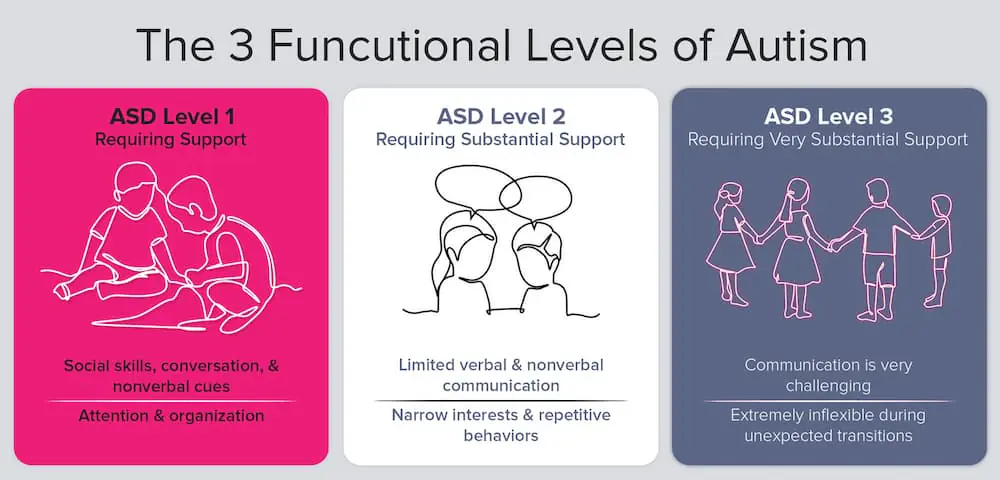When I was in school earning my master’s degree in counseling, the use of functioning labels in autism (low functioning/high functioning) was still widespread. We didn’t know what we didn’t know, which is that there are more effective, less harmful ways to talk about how autism affects someone. I still hear these labels tossed about by mental health professionals sometimes, and I try to impress upon them how labels hurt individuals labeled ‘high functioning’ and ‘low functioning’ alike. Harmful? Yes. Let’s break it down.
The idea of functional labels is behind us. There is no science behind the designations ‘high functioning’ and ‘low functioning’ and these labels were informal ways of trying to determine levels of support need. What they did, however, was minimize the needs of one group and the strengths of the other, in fact leaving them with inappropriate care. Today, we have formal measures of levels of need in the DSM-5-TR, which we’ll go over at the end of this post. So how are the functioning labels harmful?
- High functioning: You’re probably wondering why giving someone the label ‘high functioning’ can hurt someone who is autistic. After all, this label implies that they have a less serious presentation, and usually have high IQ scores. This label is a sticky wicket though. A big problem is that labeling someone as ‘high functioning’ tends to get in the way of them receiving services for their needs. An autistic child or adult with a ‘high functioning’ label might have low adaptive skills. They may need help with hygiene, making and going to doctor appointments, or things like cooking or cleaning. Assuming someone’s skills and needs based on IQ scores is dangerous business. This is one of the reasons that measuring adaptive functioning is part of any good autism evaluation.
- Low Functioning: Another sticky wicket. Often, ‘low functioning’ individuals are also nonverbal, so they can’t speak up and defend themselves. I’m pretty good at saying it like it is, as many of you already know, so here it is. Autistic individuals formerly known as ‘low functioning’ may exhibit unique skills and abilities including amazing visual thinking, attention to detail, honesty, a strong visual memory, and sometimes even savant skills like exceptional mathematical abilities, musical talent, or the ability to know the day of the week if given a date on the calendar five years ago, despite having challenges in communication and daily living skills. I have seen some of these abilities in person, and they are pretty inspiring.
This is a fun video about the outdated use of functioning labels by an autistic adult.
So what are the alternatives? When the DSM-5 came out, it started including levels of severity based on two areas: social communication and restricted/repetitive behaviors. These levels of severity are a comparison to neurotypical behaviors, so I’m guessing they will be on their way out the door soon … but deciding what a level of severity is … another sticky wicket.
Level 1: Requires Support
Level 1 describes autistic people who require support but have low support needs. That is kind of like saying two completely opposite things at once.
Interventions for autistic people with low support needs may include:
- Group or individual therapy designed to boost communication and social skills
- Support at school or work in the form of accommodations
- Independent living skills
- Identifying any mental health needs and getting effective treatment
Level 2: Requires Substantial Support
The DSM’s Level 2 expression of autism includes people who have very specific interests and who engage in repetitive behaviors.
For example, an autistic child may pace back and forth during a class, or an adult says the same thing over and over in a meeting. These behaviors are types of stimming.
Support needs for Level 2 autism can include:
- Speech therapy services to assist with verbal communication
- Behavioral therapy to promote flexibility and minimize stimming traits or repetition (There are a lot of sticky wickets in this article!) Stimming is okay!
- Assistive technologies and tools to help with independent living skills
Level 3: Requires Very Substantial Support
Autistic children and adults with Level 3 diagnoses need the most support. They may have many of the same traits as their autistic peers but have a lot of difficulty with self-regulation. Challenges with repetitive behavior and communication are assessed as making it difficult to complete daily living tasks, interact socially, and deal with a change in focus or location.
Generally, autistic people with high support needs may require:
- Alternative speech and communication strategies for nonverbal people, such as augmentative and alternative communication (AAC) devices or using social stories
- Routine or round-the-clock care to ensure feeding, bathing, and other basic needs are met
- Medication and other treatments for physical, cognitive, and mental health concerns
- Advocacy to ensure they receive services and are protected from discrimination and abuse
These levels of severity can change within the same individual over time.
How is that different?
It’s not. If these levels also seem unhelpful, it’s because they are. As I mentioned above, severity levels are based on a combination of social communication difficulties and restricted, repetitive patterns of behavior. Clinicians use their clinical judgment to decide on the level that best describes the severity of an autistic child or adult’s condition. So once again, this is not science based, but more of a gut-based decision. So, how can we describe level of severity or need?
In my opinion, it is through honest descriptions.
- John has sensory sensitivities to sound and bright lights that interferes with his ability to attend school and work.
- Although Mary excels in visual learning, she needs extra time to process auditory information. This interferes with her work, and she has been fired from 3 jobs as a result.
Honest descriptions and how they impact functioning are the best expressions of need!
